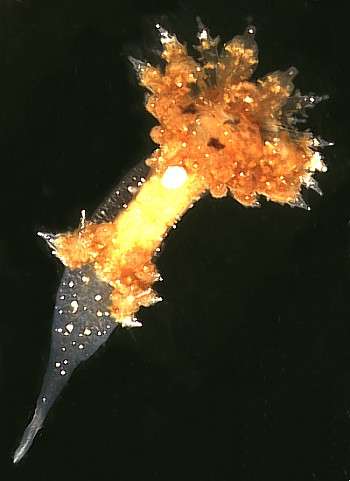
Janolus mirabilis
Baba & Abe, 1970
Order: NUDIBRANCHIA
Suborder: ARMININA
Family: Zephyrinidae
DISTRIBUTION
Described from Japan. New records published here from the Great Barrier Reef, and east Africa suggest this species has a wide Indo-West Pacific distribution.
PHOTO
Heron Island, Great Barrier Reef, Queensland, Australia., under a dead coral slab at the reef crest, December 1997, 4 mm long alive. PHOTO: Julie Marshall.
This small species is characterised by the arrangement of the cerata into an anterior and a posterior cluster. See Julie Marshall's photos and my drawings below.
Reference:
• Baba, K. & Abe, T. (1970). Two new species of Janolidae from Toyama Bay, Japan (Gastropoda: Nudibranchia). The Veliger, 13(1): 63-66
Rudman, W.B., 1999 (July 1) Janolus mirabilis Baba & Abe, 1970. [In] Sea Slug Forum. Australian Museum, Sydney. Available from http://www.seaslugforum.net/find/janomira
Related messages
Janolus mirabilis found sthn Queensland
November 17, 2009
From: Gary Cobb

Concerning message #1000:
Hi Bill and everyone!
Well I see there has not been an entry for this species since 1999! Let the drought be over now. Aaron and I went to the Mooloolaba Rockwall Ledges dive and found a piece of hydroid with an egg mass on it. I gingerly plucked it off and put it in the collection jar.
Upon transferring everything to a white bowl I was pleasantly surprised to count 34 Doto rosacea, Polycera melanosticta, Polycera risbeci and Janolus mirabilis.
This is one mean slug! It constantly shakes its cerata when touched. It also forces its cerata forward and backward when it starts to crawl. Making it very hard to get a great photo!
The cerata are split into 2 groups, a smaller toward the posterior end. There are two large white blotches in front and behind the forward cerata group. The anterior cerata group also surrounds the rhinophores.
When at rest it resembles a small Furball!
Locality: Mooloolaba Rockwall Ledges, 3 m max depth, Queensland, Australia, Pacific Ocean, 08 November 2009, Subtidal. Length: 5 mm long. Photographer: David Mullins on microscope.
Cheers
Gary
gary@nudibranch.com.au



Dear Gary,
Thanks for these photos of this strange animal. I suspect its apparent rarity is because of its size and cryptic colouration. It's surprising how a number of unrelated species have evolved this habit of rhythmically 'jerking' their cerata [see Limenandra nodosa, Aeolidiella alba].
Is it possible the hydroid you found it on may have been a mix of hydroid and branching bryozoan? Why I ask is that while Doto certainly feeds on hydroids, species of Janolus and Polycera are feeders on branching bryozoans.
Best wishes,
Bill Rudman
More records of Janolus mirabilis
July 1, 1999
From: Terry Gosliner
Dear Bill,
It was great to see you and everyone in Sicily.
I was delighted to see the photos of Janolus mirabilis on your forum. Additional specimens have come from Midway Atoll in the outer Hawaiian Islands and Cory Pittman has recently found this species on the high Hawaiian Island of Maui. It is a very bizarre species, to say the least. Some people have suggested that the missing cerata that were originally described were the result of damage to the Japanese specimens. It is comforting to know that all the specimens from all localities have this unusual arrangement of cerata.
All the best,
Terry
tgosliner@casnotes1.calacademy.org
Janolus mirabilis from Heron Island
June 30, 1999
From: Julie Marshall


Here are two images of Janolus mirabilis which Baba & Abe (1970) described from a single specimen found in Toyama Bay, Japan, in 1958. As far as I am aware it has not been recorded since except at Heron Island. This specimen measured 4 mm and was found under a dead coral slab at the reef crest at low tide in December 1997. This species is readily identified by the exceptionally large cerata which are arranged in two clusters ,with the larger cluster encircling the rhinophores. There are insignificant papillae in the large space between the clusters. Janolus mirabilis moves with a rapid, jerking movement flicking its cerata backwards and forwards as it moves.
I found it difficult to photograph Janolus mirabilis because it moved so quickly across the petri dish - in fact is is probably the fastest moving small nudibranch I've encountered.
Reference: Baba, K. & Abe, T. 1970. Two new species of Janolidae from Toyama Bay, Japan (Gastropoda : Nudibranchia). The Veliger 13 (1): 63-66.
Julie Marshall
j.marshall@latrobe.edu.au
Marshall, J., 1999 (Jun 30) Janolus mirabilis from Heron Island. [Message in] Sea Slug Forum. Australian Museum, Sydney. Available from http://www.seaslugforum.net/find/988
Dear Julie,
Thanks for the pictures of Janolus mirabilis. I must agree its difficult to photograph. Your mention of its jerky movement reminded me I had found it in Tanzania, East Africa many years ago and was fascinated by the way it moved its cerata. I have included a couple of field drawings I made of a small specimen. The interesting thing was that the ceratal movement was very organised. As the animal crawled forward the cerata would be lying horizontally then all the cerata in the posterior cluster and the back cerata in the anterior cluster would stand up vertically in unison, then all bend down and so on. This rhythmic motion would give the impression that the slug was jerking as it moved along even though it was crawling quite smoothly.
This unpublished record from Tanzania, with yours from Heron Island, suggests that it has a wide Indo-West Pacific distribution.
The data for my record is:
Pangavini Island, off Kunduchi Beach, Dar es Salaam, Tanzania, October 1976, 6mm long alive.
Bill Rudman.
Rudman, W.B., 1999 (Jun 30). Comment on Janolus mirabilis from Heron Island by Julie Marshall. [Message in] Sea Slug Forum. Australian Museum, Sydney. Available from http://www.seaslugforum.net/find/988